|
|
|
Sort Order |
|
|
|
Items / Page
|
|
|
|
|
|
|
| Srl | Item |
| 1 |
ID:
116743


|
|
|
|
|
| Publication |
2012.
|
| Summary/Abstract |
A dominant resistance factor against wind power projects seems to be their visual impact on the landscape. In addition stress effects from aircraft obstruction markings are an emerging topic related to acceptance. As the height of wind turbines increases, so does the number of mandatory obstruction markings. Recently, obstruction markings have caused a growing number of complaints from residents. Whether obstruction markings indeed cause stress or even substantial annoyance remains an open question. To analyse the stress impact of obstruction markings, we used environmental and stress psychology methodologies. Residents (N=420) with direct sight of turbines at 13 wind farms participated in a questionnaire survey. Evidence of substantial annoyance caused by obstruction markings was not found. However, residents exposed to xenon lights reported more intense and multifaceted stress responses than exposed to LED or colour markings on blades. Moreover, xenon lights negatively affected the general acceptance of wind energy. Additionally, synchronised navigation lights were found to be less annoying than non-synchronised lights under certain weather conditions. Markings with light intensity adjustment proved to be advantageous. To reduce stress and increase social acceptance of wind power, xenon lights should be abandoned, navigation lights synchronised, and light intensity adjustment applied.
|
|
|
|
|
|
|
|
|
|
|
|
|
|
|
|
| 2 |
ID:
191170
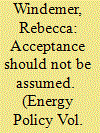

|
|
|
|
|
| Summary/Abstract |
Local community acceptance is a key influence on wind farm siting decisions. However, there is a temporal limitation to much social acceptance literature in that it does not consider how perceptions of the local community may change over the operational life of a wind farm and in the context of end-of-life applications for repowering or life-extension. In response, this paper increases the temporal depth of our understanding of social acceptance through presenting the results of survey research undertaken with communities living close to two English wind farms that have experienced end-of-life applications. For many respondents, perceptions of their local wind farm did not change following construction or over the life of the scheme, contrasting with common expectations that acceptance will increase over time. The findings reveal that community support for applications to repower or life-extend is influenced by experiences of living with the wind farm over time. It also shows how factors that have been found to impact perceptions of new wind farms, particularly the benefits that people experience, involvement in the planning process, and relationships with the developer, can influence responses to end-of-life applications. These insights are used to provide recommendations for end-of-life policy.
|
|
|
|
|
|
|
|
|
|
|
|
|
|
|
|
| 3 |
ID:
090105
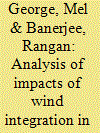

|
|
|
|
|
| Publication |
2009.
|
| Summary/Abstract |
As the share of wind in power systems increases, it is important to assess the impact on the grid. This paper combines analysis of load and generation characteristics, generation adequacy and base and peak load variations to assess the future role of wind generation. A simulation of Tamil Nadu in India, with a high penetration of wind power (27% by installed capacity), shows a capacity credit of 22% of the installed wind capacity. For seasonal wind regimes like India, neither the capacity factor, nor the capacity credit reflects the monthly variation in the wind generation. A new approach based on the annual load duration curve has been proposed for generation expansion planning with higher penetration of wind. The potential savings in base and peak capacity required with increasing wind power have been quantified. A future scenario for Tamil Nadu for 2021 has been illustrated. It was found that 5500 MW of wind power can save 3200 MU of peak energy required or an average peak capacity of 2400 and 1100 MW of base capacity. This analysis would be useful to assess the future impacts of increasing wind capacity in grids.
|
|
|
|
|
|
|
|
|
|
|
|
|
|
|
|
| 4 |
ID:
125808


|
|
|
|
|
| Publication |
2013.
|
| Summary/Abstract |
This work investigates the interaction between wind power and electricity markets. The paper is focused on balancing markets pricing policies. The proposal of a new imbalance price scheme is included and conveniently evaluated. This proposed scheme tries to minimise the use of ancillary services to compensate for deviations in searching for a more efficient market design. The effectiveness of imbalance prices as market signals is also examined, and policy recommendations regarding imbalance services are discussed. Two test cases are included that analyse the participation of a wind power producer in the Spanish electricity market using a stochastic optimisation strategy. For this purpose, the uncertainty of the variables is considered, i.e., wind power production and prediction, intraday and imbalance prices. Test cases were run with real data for 10 months, and realistic results are presented along with a hypothetical test case. The regulation of the imbalance prices may not be adequate for the Spanish electricity market because an error drop is not sufficiently encouraged. Therefore, we suggest the application of a new imbalance price scheme, which includes an additional constraint. The conclusions of this paper can be assumed to be general policy recommendations.
|
|
|
|
|
|
|
|
|
|
|
|
|
|
|
|
| 5 |
ID:
181806


|
|
|
|
|
| Summary/Abstract |
Two financial incentives that have spurred the growth of renewable energy including wind farms are Production Tax Credits (PTC) and Property Tax Abatement (PTA). PTC provides a tax credit of 1¢–2¢ per kilowatt-hour for the first 10 years of electricity generation for utility-scale wind, and PTA is a rebate provided by the local governments to wind farms in the U.S. Midwestern states. Past researches suggest that the breaking-even of renewable energy projects can partly be attributed to PTC. However, in cognizance of the irregular availability of such incentives, there seems to exist a need for financial feasibility analysis of the wind farms. The study uses a stochastic method and a scenario approach to address this research question. The analysis considers the capital and operating costs, interest payments, local and federal taxes, and production of wind energy and sales revenues, and inherent uncertainties in key parameters. The results shed some light on the impacts of PTC and PTA on the financial feasibility of wind farms in the U.S. Midwestern states. It is observed that PTC is a more effective instrument compared to PTA. The paper concludes by discussing policy implications of local government rebates and federal incentives.
|
|
|
|
|
|
|
|
|
|
|
|
|
|
|
|
| 6 |
ID:
123591


|
|
|
|
|
| Publication |
2013.
|
| Summary/Abstract |
We bring together a collection of papers that were presented at the inaugural event of the Asia-Europe Energy Policy Research Network (AEEPRN), held at Singapore in May 2012. The idea for creating AEEPRN was in response to the growing importance of energy in Asia and Europe's relations and to our shared belief that energy will become a more significant aspect of these relations over the forthcoming years and decades. The papers presented here cover the following themes: wind energy, biofuels, natural gas and gas pipelines, exergy and manufacturing, green energy co-operation, coal, unconventional gas and solar energy.
|
|
|
|
|
|
|
|
|
|
|
|
|
|
|
|
| 7 |
ID:
127211
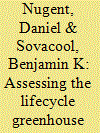

|
|
|
|
|
| Publication |
2014.
|
| Summary/Abstract |
This paper critically screens 153 lifecycle studies covering a broad range of wind and solar photovoltaic (PV) electricity generation technologies to identify 41 of the most relevant, recent, rigorous, original, and complete assessments so that the dynamics of their greenhouse gas (GHG) emissions profiles can be determined. When viewed in a holistic manner, including initial materials extraction, manufacturing, use and disposal/decommissioning, these 41 studies show that both wind and solar systems are directly tied to and responsible for GHG emissions. They are thus not actually emissions free technologies. Moreover, by spotlighting the lifecycle stages and physical characteristics of these technologies that are most responsible for emissions, improvements can be made to lower their carbon footprint. As such, through in-depth examination of the results of these studies and the variations therein, this article uncovers best practices in wind and solar design and deployment that can better inform climate change mitigation efforts in the electricity sector.
|
|
|
|
|
|
|
|
|
|
|
|
|
|
|
|
| 8 |
ID:
166370
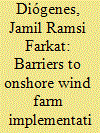

|
|
|
|
|
| Summary/Abstract |
Across the world, several developing countries with recent wind energy (WE) diffusion have been demonstrating an interest in expanding WE generation quickly and expressively. In Brazil, this fast and remarkable WE diffusion process started in the past decade, facing a variety of barriers. This research proposes to reliably identify and analyse current barriers to the implementation of onshore wind farms in the country, aiming at informing other developing countries with the intention to expand WE utilization about potential barriers, as well as assisting the Brazilian WE sector in its efforts to keep growing sustainably. To achieve this research goal, 41 key stakeholders from the Brazilian WE sector were interviewed. Based on a content analysis of the interviews, twenty-four barriers where identified, three of which with particular relevance: poor transmission infrastructure, unattractive financial loans and unstable macroeconomic environment. The data collected suggests a serious risk that Brazil's WE sector stops growing if the recovery of its national economy, the reestablishment of regular energy auctions, the access to competitive credit, and improvements to the transmission system infrastructure keep being held back. In the face of this scenario, this study concludes by providing policy recommendations concerning the sustainability of the Brazilian WE sector.
|
|
|
|
|
|
|
|
|
|
|
|
|
|
|
|
| 9 |
ID:
111462
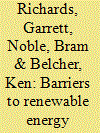

|
|
|
|
|
| Publication |
2012.
|
| Summary/Abstract |
Renewable energy is receiving increased attention as a viable alternative to non-renewable electrical generation, however, meeting global energy demands will require a more ambitious renewable energy program than is currently the case. There have been several reviews of potential technological, economic, social, or public barriers and solutions to renewable energy investment. Although important, there is also need for multi-dimensional analyses of these barriers and identification of the most significant underlying barriers if viable solutions are to be developed. In this paper we apply a theoretical framework to examine stakeholder's perceptions and understanding of the barriers to wind energy development in Saskatchewan, Canada. We identify and examine the most significant underlying barriers to investment in renewable energy and the interactions between those barriers. Results show a number of perceived barriers to wind energy investment, however, these barriers can be explained in large part by knowledge barriers, if not disagreement over whether the current level of investment in wind energy is sufficient. We show that barriers to renewable energy cannot be explained solely by technological, social, political, or economic factors in isolation, and that a multi-dimensional approach, identifying and explaining the underlying sources of these barriers, is necessary to develop viable solutions.
|
|
|
|
|
|
|
|
|
|
|
|
|
|
|
|
| 10 |
ID:
115156


|
|
|
|
|
| Publication |
2012.
|
| Summary/Abstract |
We investigate the economic viability of coupling a wind farm with compressed air energy storage (CAES) to participate in the day-ahead electricity market at a time when renewable portfolio standards are not binding and wind competes freely in the marketplace. In our model, the CAES is used to reduce the risk of committing uncertain quantities of wind energy and to shift dispatch of wind generation to high price periods. Other sources of revenue (capacity markets, ancillary services, price arbitrage) are not included in the analysis. We present a model to calculate profit maximizing day-ahead dispatch schedules based on wind forecasts. Annual profits are determined with dispatch schedules and actual wind generation values.
We find that annual income for the modeled wind-CAES system would not cover annualized capital costs using market prices from the years 2006 to 2009. We also estimate market prices with a carbon price of $20 and $50 per tonne CO2 and find that revenue would still not cover the capital costs. The implied cost per tonne of avoided CO2 to make a wind-CAES profitable from trading on the day-ahead market is roughly $100, with large variability due to electric power prices.
|
|
|
|
|
|
|
|
|
|
|
|
|
|
|
|
| 11 |
ID:
127911


|
|
|
|
|
| Publication |
2014.
|
| Summary/Abstract |
Wind energy has been negotiated in Brazil's regulated market through auctions organized by the government. Bilateral negotiations in the free market have been scarce. In 2011 wind farms were allowed to bid in 'A minus 5 (A?5)' auctions, for energy with first delivery date 5 years ahead. This new design was expected to stimulate negotiations in the free market, as the 20-year contract in the regulated market eases financing while the 5-year grace period grants wind farms the option to sell whatever energy is generated beforehand in the free market. We modeled bidders' price decision in A?5 auctions as Real Options and concluded that given the low prices averaging USD 50/MW h, winners are tempted to defer investment, expecting more favorable equipment and energy prices, or a better knowledge of the wind site. Construction is likely to begin in 2-3 years, with little time left for the free market. Bidders that consider the option of eventually abandoning the project are more price competitive, increasing chances that some wind farms will never materialize. Therefore, this attempt to foster the free market may not pay-off and, moreover, it may have the unfavorable effect of turning Brazil's energy expansion planning a more difficult task.
|
|
|
|
|
|
|
|
|
|
|
|
|
|
|
|
| 12 |
ID:
085511
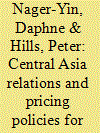

|
|
|
|
|
| Publication |
2008.
|
| Summary/Abstract |
Renewable energy, although capable of making a significant contribution to the achievement of sustainable development, has, however, failed to reach its full potential in mist countries. A major challenge of the sustainability tradition is how to translate sustainable development from a concept to effective implementation. However, the mechanisms through which the concept of sustainable development can be into operation remain an area largely unexplored in the energy
|
|
|
|
|
|
|
|
|
|
|
|
|
|
|
|
| 13 |
ID:
120105
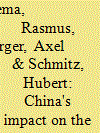

|
|
|
|
|
| Publication |
2013.
|
| Summary/Abstract |
China's economic rise has transformed the global economy in a number of manufacturing industries. This paper investigates whether China's transformative influence extends to the new green economy. Drawing on the debate about how China is driving major economic changes in the world - the "Asian drivers" debate - it identifies five corridors of influence and investigates their relevance for the wind energy industries. Starting with the demand side, it suggests that the size and rapid growth of the Chinese market have a major influence on competitive parameters in the global wind power industry. While Western firms have found ways of participating in the growth of the Chinese market, the government's procurement regimes benefit Chinese firms. The latter have invested heavily and learned fast, accumulating production capabilities that have led to changes in the global pecking order of lead firms. While the combined impact of Chinese market and production power is already visible, other influences are beginning to be felt - arising from China's coordination, innovation and financing power.
|
|
|
|
|
|
|
|
|
|
|
|
|
|
|
|
| 14 |
ID:
162337
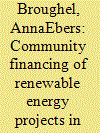

|
|
|
|
|
| Summary/Abstract |
Small-scale investors are gaining recognition as a valuable source of private funding necessary for a successful energy transition. Still, there is limited knowledge about the characteristics of potential investors, especially in community renewable energy projects. This study intends to address this gap and investigates the impact of socio-demographic and socio-psychological characteristics on individuals’ willingness to invest in community renewable energy projects. Our investigation is based on two large-scale representative surveys of 2260 respondents in Austria and Switzerland. The majority of respondents would be willing to invest 1000 to 10,000 CHF/EUR in such a project, with higher amounts in the Swiss sample. Potential investors in Austria tend to be male homeowners with higher incomes, while Swiss investors are more educated. Generally, positive attitudes and beliefs related to renewable energy have a significant impact on investment intention. The largest group of potential investors in both countries can be described as ‘urban wind energy enthusiasts’, who show high acceptance of wind energy installations near their communities. Surprisingly, a significant segment of potential investors is skeptical of a nearby wind installation. Study results can be used by decision-makers to tailor appropriate policy measures and by project developers for communication of the project aims and benefits.
|
|
|
|
|
|
|
|
|
|
|
|
|
|
|
|
| 15 |
ID:
162342
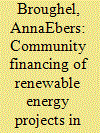

|
|
|
|
|
| Summary/Abstract |
Small-scale investors are gaining recognition as a valuable source of private funding necessary for a successful energy transition. Still, there is limited knowledge about the characteristics of potential investors, especially in community renewable energy projects. This study intends to address this gap and investigates the impact of socio-demographic and socio-psychological characteristics on individuals’ willingness to invest in community renewable energy projects. Our investigation is based on two large-scale representative surveys of 2260 respondents in Austria and Switzerland. The majority of respondents would be willing to invest 1000 to 10,000 CHF/EUR in such a project, with higher amounts in the Swiss sample. Potential investors in Austria tend to be male homeowners with higher incomes, while Swiss investors are more educated. Generally, positive attitudes and beliefs related to renewable energy have a significant impact on investment intention. The largest group of potential investors in both countries can be described as ‘urban wind energy enthusiasts’, who show high acceptance of wind energy installations near their communities. Surprisingly, a significant segment of potential investors is skeptical of a nearby wind installation. Study results can be used by decision-makers to tailor appropriate policy measures and by project developers for communication of the project aims and benefits.
|
|
|
|
|
|
|
|
|
|
|
|
|
|
|
|
| 16 |
ID:
162943
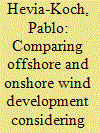

|
|
|
|
|
| Summary/Abstract |
Cost efficient deployment of wind energy is in focus for reaching ambitious targets for renewable energy and transforming the energy supply to one based on renewables. However, as more wind is being deployed the available sites onshore become less attractive in terms of wind conditions and capacity factor and more resistance from population groups affected in the deployment areas results in a reduction of areas that can be developed. We consider three different methods for estimating acceptance costs, one based on compensation and property purchase costs, one based on property value loss near wind turbines, and one based on willingness to pay calculated from a stated preference study. Utilising these methods, we provide an estimation of Levelised Cost of Energy (LCOE) for an expansion of 12 GW onshore or offshore wind capacity in Denmark. We find that the three methods provide similar estimates for local acceptance, but that a high range of uncertainty exists in the upper bound of acceptance costs. Onshore does not have a clear-cut cost advantage over offshore when considering substantial amounts of wind capacity expansion and using high estimates for nation-wide acceptance costs. Moderate onshore wind expansion considering only local acceptance has a cost advantage.
|
|
|
|
|
|
|
|
|
|
|
|
|
|
|
|
| 17 |
ID:
116722
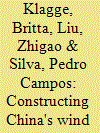

|
|
|
|
|
| Publication |
2012.
|
| Summary/Abstract |
The rapid rise of China as the largest wind energy market worldwide with several global leaders in turbine manufacturing received much attention from both scholarly and policy-analytical work. However, little attention has been given to the innovation activities of the Chinese wind industry. In our paper, we aim to address this gap, based on second-hand sources and over 50 personal interviews with wind energy-related experts. We argue that China's wind industry has made great progress in terms of manufacturing and installing, but is confronted with various challenges and problems regarding the development of its indigenous innovation capabilities. Using innovation systems approaches as an analytical tool and focusing on institutions, actors, technology and their interaction in supporting innovation activities, we decompose the elements of China's wind energy innovation system and their role in developing the domestic wind industry. Against this backdrop we identify and discuss challenges and obstacles in the development of an innovation-driven wind industry in China. The paper strongly argues that more attention should be paid to improve the coordination and cooperation among the various actors of the wind energy innovation system, to the build-up of a market-oriented education and training system as well as to intellectual property protection.
|
|
|
|
|
|
|
|
|
|
|
|
|
|
|
|
| 18 |
ID:
088222


|
|
|
|
|
| Publication |
2009.
|
| Summary/Abstract |
This article explores the threats that wind farms pose to birds and bats before briefly surveying the recent literature on avian mortality and summarizing some of the problems with it. Based on operating performance in the United States and Europe, this study offers an approximate calculation for the number of birds killed per kWh generated for wind electricity, fossil-fuel, and nuclear power systems. The study estimates that wind farms and nuclear power stations are responsible each for between 0.3 and 0.4 fatalities per gigawatt-hour (GWh) of electricity while fossil-fueled power stations are responsible for about 5.2 fatalities per GWh. While this paper should be respected as a preliminary assessment, the estimate means that wind farms killed approximately seven thousand birds in the United States in 2006 but nuclear plants killed about 327,000 and fossil-fueled power plants 14.5 million. The paper concludes that further study is needed, but also that fossil-fueled power stations appear to pose a much greater threat to avian wildlife than wind and nuclear power technologies.
|
|
|
|
|
|
|
|
|
|
|
|
|
|
|
|
| 19 |
ID:
191179
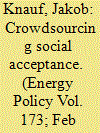

|
|
|
|
|
| Summary/Abstract |
Citizen co-investment in wind energy projects has recently received a lot of attention among scholars and policymakers as a way to finance renewable energy projects and increase community acceptance of these projects. Citizen co-investment refers to the process by which members of the local community can financially participate in renewable energy projects prior to or shortly after construction. While previous research has often been cross-sectional and focused on the preferences of citizen-investors, this paper focuses on the perspective of project developers and asks why, when and how they offer citizens the opportunity to co-invest in wind farms. The work is based on the analysis of fourteen in-depth interviews with a sample of experienced German wind energy developers. The analysis shows that the decision to offer co-investment is driven by citizen demand and local stakeholder preferences, rather than financial needs. We shed light on how experienced developers deal with key trade-offs in terms of the timing of their offering and the choice of capital structure. As a result, we offer a number of testable propositions for further research on the nuanced relationship between citizen co-investment and social acceptance and derive recommendations for policymakers.
|
|
|
|
|
|
|
|
|
|
|
|
|
|
|
|
| 20 |
ID:
132646
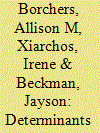

|
|
|
|
|
| Publication |
2014.
|
| Summary/Abstract |
This article offers the first national examination of the determinants of adoption of wind and solar energy generation on U.S. farming operations. The inclusion of state policies and characteristics in a multilevel modeling approach distinguishes this study from past research utilizing logit models of technology adoption which focus only on the characteristics of the farm operation. Results suggest the propensity to adopt is higher for livestock operations, larger farms, operators with internet access, organic operations, and newer farmers. The results find state characteristics such as solar resources, per capita income levels, and predominantly democratic voting increasing the odds of farm adoption. This research suggests the relevance of state policy variables in explaining farm level outcomes is limited, although in combination best practice net metering and interconnection policies-policies designed to encourage the development of small scale distributed applications-are shown to increase the likelihood of farm solar and wind adoption. The prevalence of electric cooperatives-which are often not subject to state renewable energy policies and often service farms-is negatively related with the propensity to adopt and suggests that policy design may be a factor
|
|
|
|
|
|
|
|
|
|
|
|
|
|
|
|
|
|
|
|
|